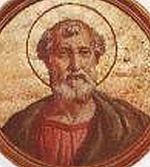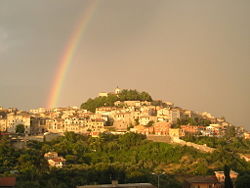Pope Sixtus I
| Saint Sixtus I | |
|---|---|

| |
| Birth name | Sixtus or Xystus |
| Papacy began | 117 or 119 |
| Papacy ended | 126 or 128 |
| Predecessor | Alexander I |
| Successor | Telesphorus |
| Born | ??? Rome, Italy |
| Died | 126 or 128 Rome, Italy |
| Other popes named Sixtus | |
Pope Saint Sixtus I was the bishop of Rome from about 117 or 119 C.E. to 126 or 128 C.E., following Pope Alexander I and succeeded by Pope Telesphorus. The spelling Xystus is also used for the first three popes named Sixtus.
Like most of the very early popes, very little is known about Sixtus. Several sources call him a martyr. However, this is considered unproved, and the "Xystus" who is commemorated in the Catholic Canon of the Mass is Sixtus II, not Sixtus I.
Sixtus I is credited as having instituted several Roman Catholic liturgical and administrative traditions, but historians believe that these were attributed to him by later writers who were interested in bolstering the papacy's claims to ancient supremacy. Like most of his predecessors, Sixtus I was believed to be buried near Saint Peter's grave in the Vatican, although there are differing traditions concerning where his body lies today. His feast is celebrated on April 6.
Biography
Sixtus was reportedly a Roman by birth, and his father's name is given as Pastor. Other than that, nothing is known about his background. The Liber Pontificalis credits him with instituting the following three ordinances:
- That only official ministers are allowed to touch the sacred vessels
- That bishops who have been summoned to Rome can only be accepted back by their diocese after presenting letters from the pope
- That after the Preface in the Mass, the priest shall chant the Sanctus ("Holy, holy, holyâ¦") together with the people
However, most historians today dismiss these claims as a later invention, for the authors of the Liber Pontificalis dutifully ascribe to each pope one or more such decrees in accord with the view of Roman church tradition stemming from an unbroken chain of apostolic authority going back to the first "pope," Saint Peter. Similar skepticism must be applied to the claim that Sixtus appointed exactly 11 priests, four deacons, and four bishops.
Regarding the dates of Sixtus I, according to the Liberian Catalogue of popes, he ruled the Church during the reign of Hadrian "a consulatu Negro et Aproniani usque Vero III et Ambibulo," that is, from 117 to 126. The fourth century church historian Eusebius, however, states in his Chronicon that Sixtus I was pope from 114 to 124, while his Historia Ecclesiastica, using a different list, claims that Sixtus' rule was from 114 to 128.

The Felician Catalogue of popes, as well as the Liber Pontificalis and various martyrologies, tells us that Sixtus I was a martyr, though no details are provided. This gives him a somewhat more credible claim to this title than several earlier popes whom the Liber Pontificalis calls martyrs. However, Irenaeus of Lyons, writing in the second century, says nothing of his martyrdom. His successor, Telesphorus, is the first bishop of Rome after Saint Peter whom Irenaeus designates a martyr.
Sixtus was reportedly buried in the Vatican, beside the tomb of Saint Peter. The Liber Pontificalis gives his date of burial as April 3.
Legacy
The relics of Saint Sixtus are said to have been transferred to Alatri in 1132, although some contend that they are still in the Vatican Basilica. The eighteenth century English Roman Catholic hagiographer Alban Butler (Lives of the Saints, April 6) stated that Pope Clement X gave some of his relics to Cardinal Jean François Paul de Gondi, who placed them in the Abbey of St. Michael in Lorraine in the seventeenth century. The Xystus who is commemorated in the Catholic Canon of the Mass is Xystus II, not Xystus I.
| Roman Catholic Popes | ||
|---|---|---|
| Preceded by: Alexander I |
Bishop of Rome Pope 115â125 |
Succeeded by: Telesphorus |
ReferencesISBN links support NWE through referral fees
- Benedict XVI. The Roman Martyrology. Gardners Books, 2007. ISBN 9780548133743.
- Chapman, John. Studies on the Early Papacy. Port Washington, NY: Kennikat Press, 1971. ISBN 9780804611398.
- Fortescue, Adrian, and Scott M. P. Reid. The Early Papacy: To the Synod of Chalcedon in 451. Southampton: Saint Austin Press, 1997. ISBN 9781901157604.
- Jowett, George F. The Drama of the Lost Disciples. London: Covenant Pub. Co, 1968. OCLC 7181392
- Loomis, Louise Ropes. The Book of Popes (Liber Pontificalis). Merchantville, NJ: Evolution Publishing. ISBN 1889758868.
This article incorporates text from the public-domain Catholic Encyclopedia of 1913.
| |||||||||||||
Credits
New World Encyclopedia writers and editors rewrote and completed the Wikipedia article in accordance with New World Encyclopedia standards. This article abides by terms of the Creative Commons CC-by-sa 3.0 License (CC-by-sa), which may be used and disseminated with proper attribution. Credit is due under the terms of this license that can reference both the New World Encyclopedia contributors and the selfless volunteer contributors of the Wikimedia Foundation. To cite this article click here for a list of acceptable citing formats.The history of earlier contributions by wikipedians is accessible to researchers here:
The history of this article since it was imported to New World Encyclopedia:
Note: Some restrictions may apply to use of individual images which are separately licensed.